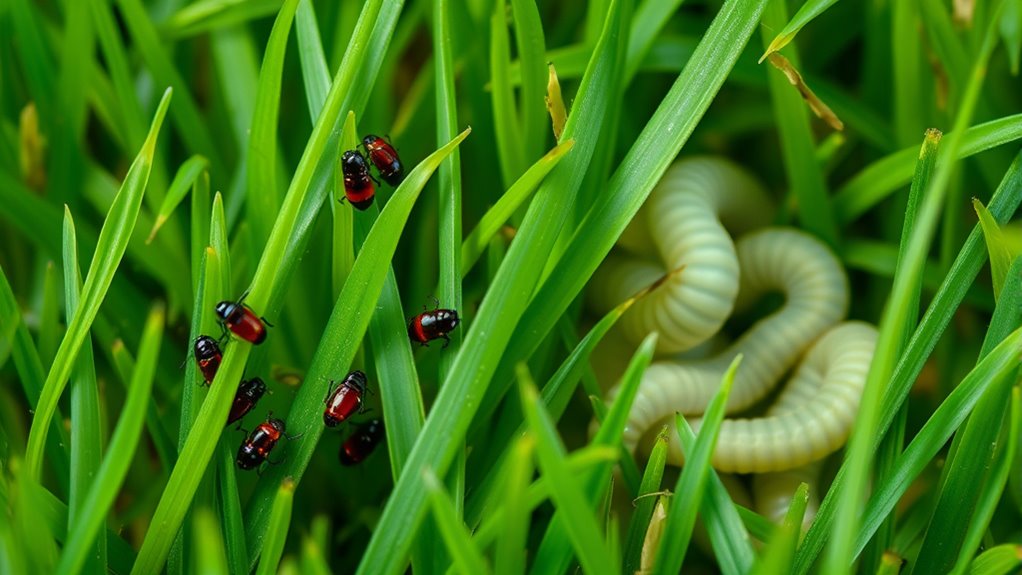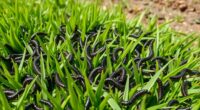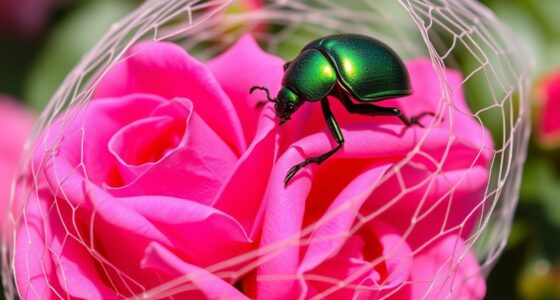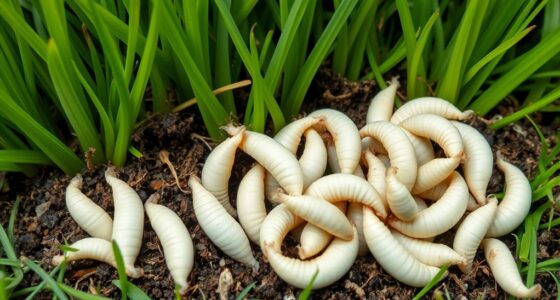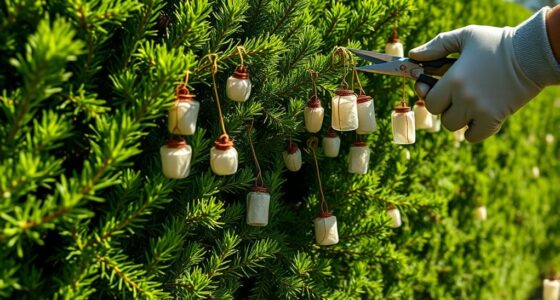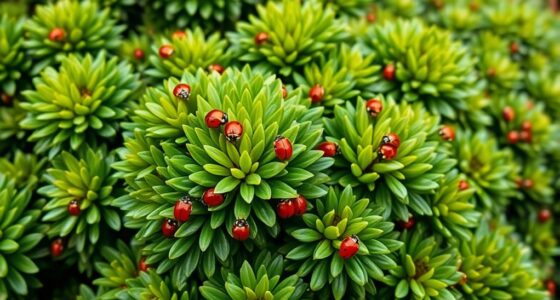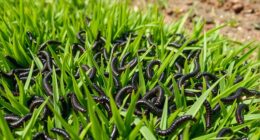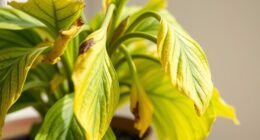Chinch bugs are tiny black insects about 1/8 inch long with white wings folded over their backs, and they hide in the thatch or along grass stems, causing yellow or brown patches. Sod webworms are caterpillars about 1/2 inch long with shiny heads, active at night, and create ragged patches by chewing grass blades. Noticing the damage pattern and pest size helps you tell them apart. To understand their lifecycles and effective control tips, keep exploring these differences.
Key Takeaways
- Chinch bugs are tiny, black insects with white wings, while sod webworms are caterpillars with green or brown bodies.
- Chinch bugs feed on grass sap, causing yellowing and browning patches; sod webworms chew grass blades, creating ragged patches.
- Chinch bugs hide in thatch or along grass stems; sod webworms are active at night, hiding in soil or thatch during the day.
- Chinch bugs lay eggs in thatch; sod webworms hatch from eggs laid on or near grass, with larvae spinning silk tunnels.
- Damage from chinch bugs appears as dead, yellow patches; sod webworms cause irregular, ragged, chewed areas on turf.
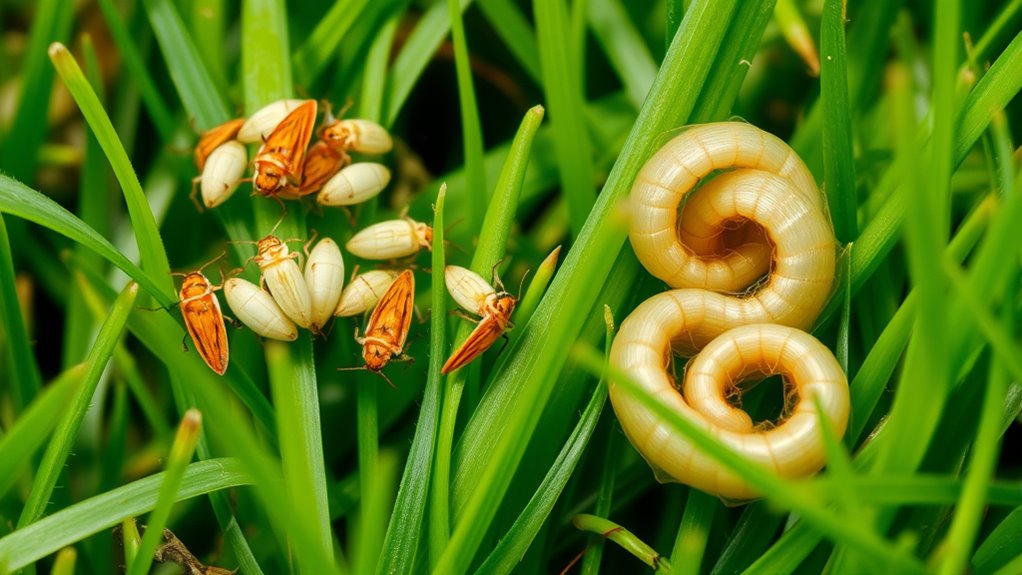
If you’re noticing patches of dead or thinning grass in your lawn, chinch bugs and sod webworms could be be the culprits. Both pests damage lawns, but they have different behaviors, appearances, and methods of attack. Recognizing these differences is key to managing them effectively. One of the best ways to start is by understanding their pest lifecycle, which reveals their vulnerabilities and helps you choose appropriate control strategies. Natural deterrents can be part of your approach, especially if you’re aiming to avoid chemical pesticides. These pests have distinct lifecycle stages, making targeted interventions more effective.
Understanding pest lifecycles helps you effectively manage chinch bugs and sod webworms naturally.
Chinch bugs are tiny insects, about 1/8 inch long, with black bodies and white wings folded over their backs. They typically hide in the thatch layer or along the stems of grass, especially in hot, dry conditions. Their lifecycle begins with eggs laid in the thatch or leaf blades, hatching into nymphs that feed on the sap of grass blades. As they mature, they insert their piercing-sucking mouthparts into the grass, extracting nutrients and weakening the plant. This feeding causes grass to turn yellow, then brown, and eventually die. Chinch bugs tend to thrive in southern regions, but they can appear anywhere, especially if the lawn is stressed or poorly maintained. Understanding pest lifecycles helps in timing your control methods more effectively.
Sod webworms are the caterpillar stage of a small moth. Their larvae are about 1/2 inch long, with a distinct green or brown body and a shiny head capsule. They hide in the thatch or soil surface during the day and come out at night to feed on grass blades. Their lifecycle begins as eggs laid on or near the grass. After hatching, the larvae feed on the turfgrass, chewing through the blades and creating irregular patches of damage. As they mature, they spin silk-lined tunnels and pupate in the soil, emerging as adult moths to repeat the cycle. Sod webworms tend to cause more visible damage as they chew through the grass blades, leading to ragged, chewed edges. Proper identification of these pests, based on their appearance and behavior, enables targeted natural control measures.
To manage these pests naturally, you can introduce beneficial insects like ladybugs or nematodes that target their larvae. Maintaining healthy grass through proper watering and fertilization also makes your lawn less inviting to pests. Avoiding excessive nitrogen fertilization can reduce lush growth that attracts chinch bugs. Regularly inspecting your lawn helps catch infestations early, increasing your chances of using natural deterrents effectively. Understanding their lifecycle stages allows you to time interventions precisely, disrupting their development and minimizing damage. Combining these natural strategies with proper lawn care creates a resilient environment, reducing reliance on chemical controls and promoting a healthier, pest-resistant lawn.
Frequently Asked Questions
Can Chinch Bugs and Sod Webworms Co-Infest the Same Lawn?
Yes, chinch bugs and sod webworms can co-infest your lawn, causing significant damage. This complicates lawn health and pest prevention efforts because each pest requires different control methods. To protect your lawn, identify the pests early, and use targeted treatments. Regular inspection and proper lawn maintenance help prevent infestations, ensuring your turf stays healthy. Acting quickly minimizes damage and keeps pests from spreading further.
Are There Natural Predators for Chinch Bugs and Sod Webworms?
Imagine an army of beneficial insects so mighty, they can outnumber chinch bugs and sod webworms! Yes, natural predators like lady beetles, lacewing larvae, and parasitic wasps provide natural control, fiercely attacking these pests. These beneficial insects act as your lawn’s defenders, reducing infestations without chemicals. You just need to encourage their presence by avoiding pesticides and creating a welcoming environment, turning your yard into a pest-free paradise.
How Long Do Chinch Bugs and Sod Webworms Typically Stay Active?
Chinch bugs and sod webworms stay active for different durations depending on their lifecycle and seasonal activity. Chinch bugs typically remain active from late spring through early fall, with a lifecycle lasting about 6 to 8 weeks. Sod webworms are most active during warm nights in summer, with a lifecycle of around 4 to 6 weeks. You should monitor your lawn closely during these periods to manage infestations effectively.
Do Different Grass Types Attract More Chinch Bugs or Sod Webworms?
Certain grass types do attract more chinch bugs or sod webworms because of their grass preference and pest attraction. For example, chinch bugs prefer warm-season grasses like St. Augustine and zoysia, making those lawns more prone to infestation. Sod webworms tend to target fescue and bluegrass, especially when those grasses are stressed or damaged. To protect your lawn, understand your grass preference and monitor pest attraction signs regularly.
What Are the Best Environmentally Friendly Treatment Options?
Think of eco-friendly treatments as your lawn’s best friends. You can use biological control methods like beneficial nematodes or natural predators to target pests without harming the environment. Organic pesticides, such as neem oil or insecticidal soaps, are also effective and safe. These options keep your lawn healthy and pest-free while protecting beneficial insects, making your yard a thriving ecosystem rather than a battleground.
Conclusion
Now that you know the signs of chinch bugs and sod webworms, you’ll notice how their damage patterns sometimes mirror each other—almost like a coincidence. Staying vigilant and inspecting your lawn regularly helps you catch these pests early. Whether it’s the tiny bugs or the webworms weaving through your grass, understanding their differences lets you act quickly. After all, catching pests early often means saving your lawn from more trouble—sometimes, coincidence is just the universe’s way of giving you a heads-up.
